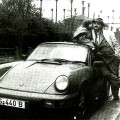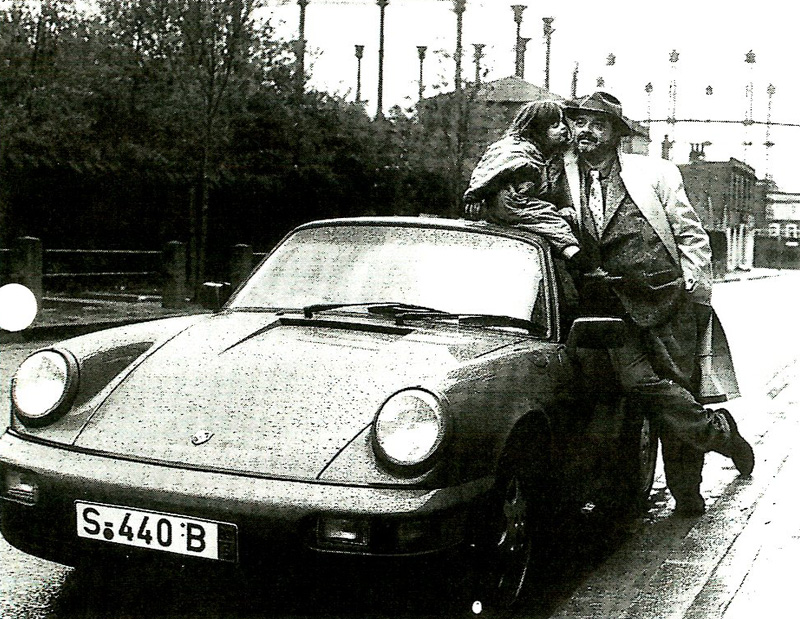-
 David Bailey
David BaileyFast Film: Porsche comes to shove for photographer David Bailey
Vanity Fair
“Should we start with the Porsches faults?” asked photographer/director David Bailey as we sat in his London studio on a miserable, dank Saturday morning. “I think after almost thirty years of building the same car they could have solved the windscreen wipers. They squeak — eeh-eeh, eeh-eeh. And they look like something from the thirties. Windscreen wipers are a big issue in England.” We had lent Bailey the $70,000 Porsche 911 Carrera 4 to see if he could find any bugs in it. He is an astute bug detector, having gone through a new car every two years or so since the sixties. I’m not the luckiest person with cars,” he explained.
Bailey loves them, but they don’t seem to love him back. Ask five people in London what he drives and they’ll each name a different model. “Tve had lots of cars,” he concurred. “A Rolls Corniche, about eight or nine years ago, the hardtop. You can’t have a soft-top in London unless you take the radio out. I lose a radio on average about every three or four months from one of my cars.” The stereo in the Porsche, a tinnysounding front-mounted Blaupunkt unit, is equipped with an anti-theft device that in theory renders it inoperative if disconnected. Only a secret code can reactivate it. Bailey maintained, perhaps in jest, that leaving the unit in the freezer overnight will neutralize the jamming device. Who knows?

Paloma Bailey's dad loves cars, and this one is nearly perfect.
“After the Rolls,” Bailey went on, “1 had a Porsche 928, and for the first year the windscreen wipers didn’t work. Then there was a terrible noise when you went over sixty, and they couldn’t seem to sort it out. The only two cars I’ve had that never went wrong are Rolls-Royces and Ferraris. And I’ve got a great thing in the country — a Mitsubishi Shogun jeep [called a Montero here). I’ve never had a problem with it. I leave it in the country sometimes for three months in the winter snows, then walk up and start it right away. Mind you, I did have one before that where the wheels collapsed in Holland Park. The BMW 750iL you see outside, which I’m happy with, replaced my 735i [the new series], which went wrong all the time. Electrics, mainly.”
Bailey doesn’t seem to have too much time for driving, what with the London-Paris-New York jet-setting to jobs (TV commercials for Reebok, Greenpeace, Volvo, Volkswagen, Chanel, etc.), and his assistants operate a sturdy jeep he provides for them. But cars are certainly on his mind. “I like my 750iL [a massive, twelve-cylinder, $70,000-plus BMW sedan] because it’s discreet,” he said. “So at first I felt like a toy boy in the Carrera 4. It seems like something Joan Collins would give you for Christmas, especially in that red. My wife wanted a BMW convertible, but I’d feel like a toy boy in that one as well. The new Mercedes SL looks butch enough to get away with — beautiful, isn’t it? Here, Mercedes has the best resale value of any car make. I couldn’t get the Porsche Speedster because there’s no backseat, and I’ve got two children and two little dogs. But I think the Carrera 4 is sensational to drive. I mean sensational. Even the seats are wonderful, the way they grip you in. The old 91 Is used to go off a bit more. But I tried to skid this one the other night in the rain, and it’s virtually impossible. I’ve never felt more safe in a car or more in control.”
The wipers seem to be the Carrera 4’s only fault. (And they never squeaked for me, although I drove the car in frequent storms from the Porsche factory in Stuttgart, all the way to London.) Otherwise, it is perfect. And very new. Although it looks like the old 911, it’s really 85 percent a different car. The upper two-thirds of sheet metal constitutes most of the holdover, and I asked Bailey if he was offended by this hideously expensive model masquerading as an old 91 I. “Well, I never understood why Jaguar stopped making the E-type. If they’d been smart, they could have made it as long as they made this Porsche. They’d be the same age now. It was one of the most beautiful cars ever made — completely Art Nouveau. It looked like it grew, rather than was manufactured. And the shape of the Porsche is still great. I’m glad they got rid of the whale tail on the back, though.” The absurd appendage Bailey was referring to was tacked onto the engine cover at the rear of the car to redirect the airflow at high speeds. Without it, a Porsche spokesperson told me, the body of the car was prone to lifting perilously off its springs. The lower third of the new body has been rounded out, and the coefficient of drag has been improved, allowing for a less tough-looking flipper. Indeed, the now petite deflector of the Carrera 4 is retractable, and lies perfectly flush with the ladybug-like 911 silhouette. After hitting fifty miles per hour or so, the Carrera 4 gets stimulated. Sensing this, a microchip quickly generates an erection: the spoiler gradually, inexorably rises to a thirty-five-degree angle with the car’s body. At six m.p.h. or so, it descends.
The 911 Carrera 4 is really the offspring, or at any rate the offshoot, of a limited-production racing car Porsche unveiled four years ago. That car, called the 959, sold out. The price was nearly $150,000, and delivery time was as much as two years. No 959s have been certified for street use in the United States, and those Americans who have ordered one will either have to sell their spots on the waiting list or drive their 959s somewhere else. In Bavaria, Gloria TNT drives one; in Geneva, Prince Sadruddin Aga Khan has a 959. These are among the richest people in the world. They are car lovers, and they don’t buy cars for investments. What’s unusual about the 959 is that it led directly to the development of the 964, which a few months ago became the 911 Carrera 4. Lots of companies develop racing cars these days, but rarely do such cars have much relation to the company’s production vehicles. Porsche, Mercedes, Ferrari, Jaguar, Honda, and Ford spend millions of dollars at the track so that their standard production cars will gain stature by association with a winner, yet one would be hard-pressed to find something that linked the Honda Prelude, for instance, to the current Formula One world-champion Honda-McLaren cars. The Jaguar racing car that has twice won the grueling Manufacturer’s Prototype series also seems far removed from the bulky, creaky XI-S, the company’s only even vaguely sporty offering to the public. But the racing cars do serve as “rolling laboratories,” where high-tech gear can be refined and proved years prior to its application in more mundane product.
Bailey could accelerate more quickly in the 911 Carrera 4 than he could in a $150,000 Ferrari Testarossa, The “4” in the name is a reference to the vehicle’s all-wheel-drive system, which helps glue the car to the road in most weather conditions. The Carrera 4 has anti-lock brakes and steering that’s power-assisted, but it is uncompromising in imparting road feel. The interior, trimmed in leather, is traditional and logical; five easily read backlit dials grace the dashboard. One of them allows the driver to check the oil level without fussing with a dipstick.
The Carrera 4 is the product of the world’s oldest and most sophisticated car culture, and could have been built only in a country where the engineers have to take the autobahn to work. It is there that the car’s Wagnerian attributes spring to life: thundering acceleration, an engine that sings, and a platform that will ride, Valkyrie-like, through stormy, brutal weather. Even at top speed the car seems to have more to give. I took it up to 160 m.p.h. and there was absolutely no vibration.
“I thought it would be a bore driving the car around London,” said Bailey. “It seems more of a long-distance car to me. But actually it was very good in the city because you can whip in and out so quick. In a way it reminded me of the Mini Cooper of the sixties — it has that nippy feel about it.” Bailey himself is an icon of the sixties, immortalized in Antonioni’s Blow-Up, a mystery story involving a quintessential fashion photographer in a swinging London studio who tools about in a Rolls convertible. “It was silly, that,” said Bailey. “I mean, I wish it was like that, my life. I could have a wonderful time rolling around in the background making money. ”
Who, I wondered, would be the Bailey character if the film were remade today? “It’d be Bruce Weber now, wouldn’t it?” Bailey quipped. “Rolling around and lots of boys with short hair. ” And what would he drive? “What car would Bruce choose? Well, he’s got so much taste, maybe he’d choose a Bristol” (a hand-built English luxury car).
Or maybe a Carrera 4. MG
published September 1989, photography by Stephanie Rushton

